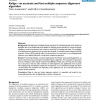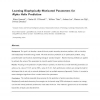50 search results - page 9 / 10 » Can Clustal-style progressive pairwise alignment of multiple... |
BMCBI
2004
13 years 5 months ago
2004
Background: In a previous paper, we introduced MUSCLE, a new program for creating multiple alignments of protein sequences, giving a brief summary of the algorithm and showing MUS...
BMCBI
2005
13 years 5 months ago
2005
Background: The alignment of multiple protein sequences is a fundamental step in the analysis of biological data. It has traditionally been applied to analyzing protein families f...
GCB
2003
Springer
13 years 10 months ago
2003
Springer
Clustering of EST data is a method for the non-redundant representation of an organisms transcriptome. During clustering of large amounts of EST data, usually some large clusters ...
BMCBI
2007
13 years 5 months ago
2007
Background: Our goal is to develop a state-of-the-art protein secondary structure predictor, with an intuitive and biophysically-motivated energy model. We treat structure predict...
BMCBI
2004
13 years 5 months ago
2004
Background: The program InDeVal was originally developed to help researchers find known regions of insertion/deletion activity (with the exception of isolated single-base indels) ...


